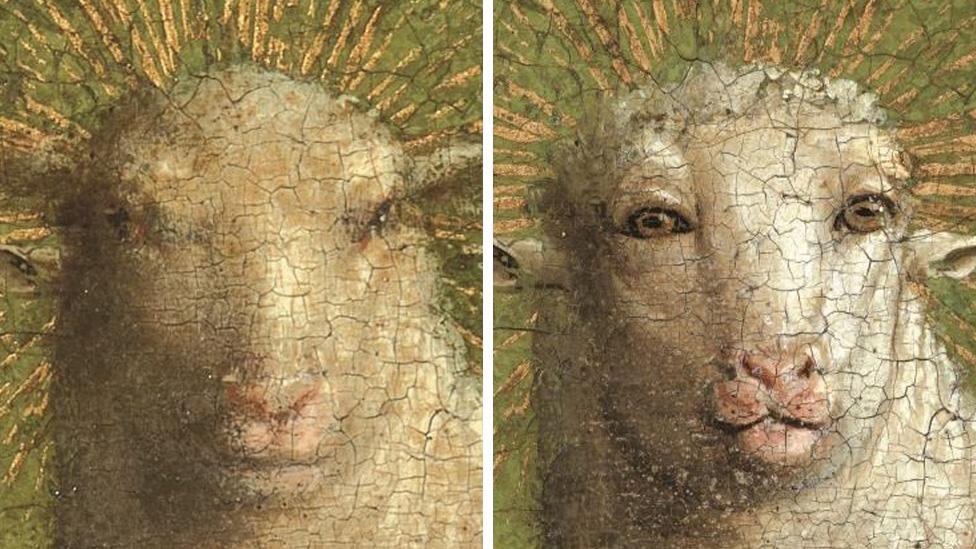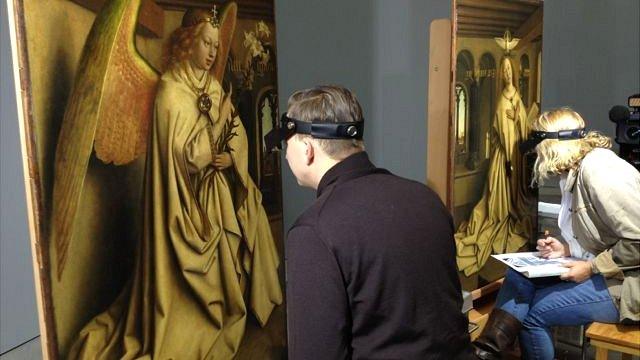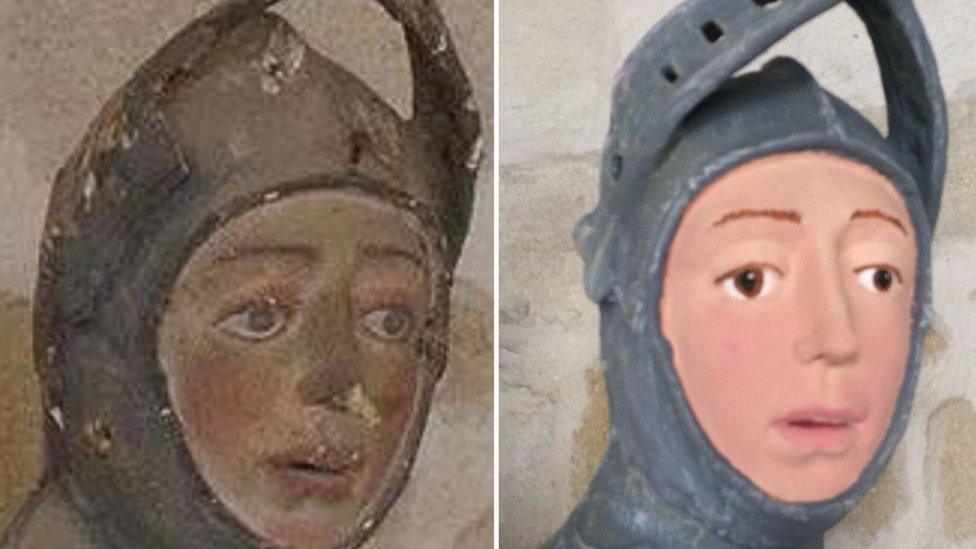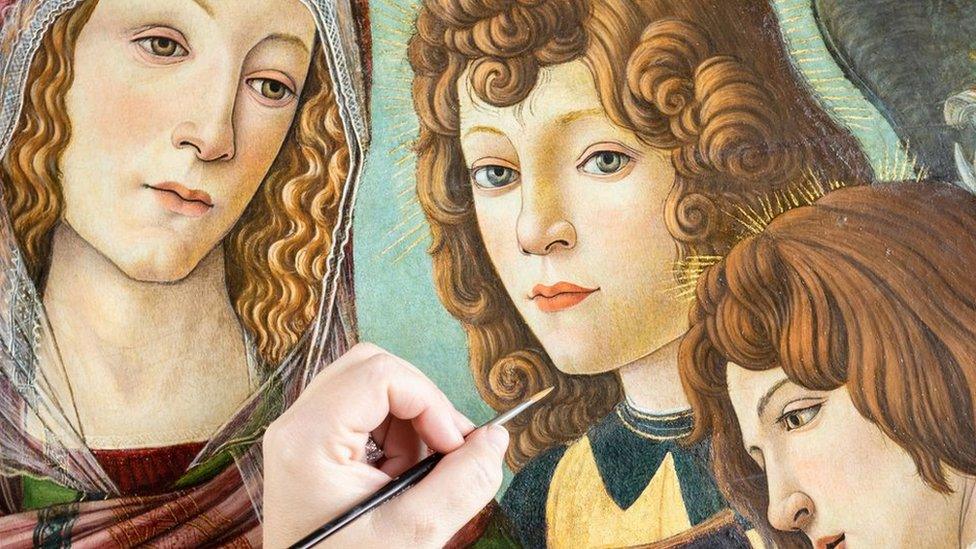Ghent Altarpiece: Lamb's 'alarmingly humanoid' face surprises art world
- Published

The Ghent Altarpiece's Lamb of God, pictured here before (L) and after the restoration
The restoration of a prized 15th Century painting has revealed the "human-like face of a lamb", surprising art critics and spurring debate.
The Ghent Altarpiece, completed by Hubert and Jan Van Eyck in 1432, has captivated the art world for centuries.
Housed at St Bavo's Cathedral in Ghent, Belgium, it is seen as the first major oil painting to gain global fame.
Since 2012, a 2.2m euro (£1.8m; $2.4m) project to restore the artwork has been taking place at a museum in Belgium.
In the second phase of the project, which ended last month, restorers made some unexpected discoveries.

A project to restore the The Ghent Altarpiece has been ongoing since 2012
Restorers found that the central panel of the artwork, known as the Adoration of the Mystic Lamb, had been painted over in the 16th Century.
Another artist had altered the Lamb of God, a symbol for Jesus depicted at the centre of the panel.
Now conservationists have stripped away the overpaint, revealing the lamb's "intense gaze" and "large frontal eyes".
Hélène Dubois, the head of the restoration project, told the Art Newspaper the original lamb had a more "intense interaction with the onlookers", external.
She said the lamb's "cartoonish" depiction, which departs from the painting's naturalistic style, required more research.
The restoration was completed late in December last year, but the results only recently started to make headlines and garner attention on social media.
Like the restoration team, others have expressed astonishment at the lamb's face.
Allow X content?
This article contains content provided by X. We ask for your permission before anything is loaded, as they may be using cookies and other technologies. You may want to read X’s cookie policy, external and privacy policy, external before accepting. To view this content choose ‘accept and continue’.

Allow X content?
This article contains content provided by X. We ask for your permission before anything is loaded, as they may be using cookies and other technologies. You may want to read X’s cookie policy, external and privacy policy, external before accepting. To view this content choose ‘accept and continue’.

The lamb has been described as having an "alarmingly humanoid face" with "penetrating, close-set eyes, full pink lips and flared nostrils" by the Smithsonian Magazine.
These features are "eye-catching, if not alarmingly anthropomorphic", said the magazine, the official journal of the Smithsonian Institution.
There was also disbelief on social media, where the lamb was called "disturbing" by some and compared to an "alien creature". Some said they felt it would have been better to not restore the lamb's original face.
Allow X content?
This article contains content provided by X. We ask for your permission before anything is loaded, as they may be using cookies and other technologies. You may want to read X’s cookie policy, external and privacy policy, external before accepting. To view this content choose ‘accept and continue’.

Allow X content?
This article contains content provided by X. We ask for your permission before anything is loaded, as they may be using cookies and other technologies. You may want to read X’s cookie policy, external and privacy policy, external before accepting. To view this content choose ‘accept and continue’.

Koenraad Jonckheere, a professor of Renaissance and Baroque art at Ghent University, speculated that the overpainting was done to neutralise the "intense and humanised identification of the lamb into an expressionless animal".
Belgium's Royal Institute for Cultural Heritage (RICH), which led the restoration, said the overpaint was removed incrementally over three years to reveal the original sheep.
In a statement to the BBC, the institute defended the restoration campaign, saying "several posts on social media reflect a misunderstanding of the results".
The Van Eyck brothers chose to "represent the Lamb of God with human-like staring eyes", which was a common style in the Middle Ages, it said.
"The choice for removing the overpaint was carefully weighed out, and it was fully supported by all involved," the institute said. "The results of the restoration have been praised by experts, the public and St Bavo's Cathedral."
The painting is known as the Adoration of the Mystic Lamb, because of the central panel which shows pilgrims clustered together to pay homage to the Lamb of God, a representation of Jesus Christ.
The altarpiece, by Flemish artist Jan Van Eyck, is almost 600 years old
On 24 January, the panel will be returned to St Bavo's Cathedral, where it will be put on public display.
The painter of the panel, Jan Van Eyck, is considered to be one of the most technical and talented artists of his generation. However, it is widely believed that The Ghent Altarpiece was started by his brother, Hubert Van Eyck.
Taken away by the Nazis during World War Two and Napoleon's troops in the 1700s, the altarpiece is thought to be one of the most frequently stolen artworks of all time.
- Published11 October 2012

- Published26 June 2018

- Published28 March 2019
